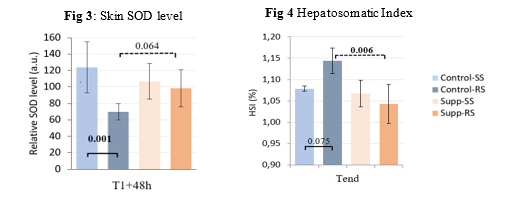FUNCTIONAL NUTRITION MITIGATES THE IMPACT OF REPETITIVE NON-MEDICINAL INTERVENTIONS IN SEAWATER ATLANTIC SALMON
Introduction
Non-medicinal interventions against parasitic infections have unequivocal benefits but impose repetitive exposure to external stressors and associated handling with the potential of severely compromise fish health and performance. Strategies that bolster mucosal robustness and mitigate physiological stress are therefore critical to support current de-medication effort. The study applied a repetitive-stress model mimicking current commercial practices against ectoparasites to evaluate the putative benefits of a blend of functional feed ingredients on the fish stress, oxidative, immune and mucosal status with the view to mitigate the impact of such practices. The blend consisted of a multi-strain yeast fraction product (MsYF; Rawling et al.; 2021) along with a Melon Pulp Concentrate (MPC) rich in the primary antioxidant superoxide dismutase (SOD; Carillon et al., 2013) previously shown to stimulate skin SOD level in Atlantic salmon (Barbé et al., 2018).
Materials and Methods
The 9-week trial tested 4 groups (2 diets x 2 stressors schedule) in triplicate using 500 g Atlantic salmon (37 fish / tank; 12°C, 36 ppt). The test diets consisted of a baseline diet non-supplemented (Control diet; BioMar) or supplemented (Supp diet) pre-extrusion with MsYF and MPC (800 g/t feed and 50 g/t respectively; Lallemand SAS, France); fed ad-libitum over the trial duration. The stressors schedule consisted of exposure to either a single-stressor (SS) or to repeated-stressors (RS) as follow: after a 5-week preparation phase, the RS group was crowded and netted-out 3 times at weekly intervals for immersion into 2 freshwater bath (1h) and a hydrogen peroxide bath (H2O2; 30 min; 1500 mg/L) then given a 2-week recovery period. In comparison, the SS group was exposed to the H2O2 bath only (no prior handling). Sampling was performed immediately prior (T1), 1 h (T1+1h), 48 h (T1+48h) and 2-week after (Tend) H2O2 exposure. Sampling documented the primary stress response, antioxidant status, mucosal integrity, innate immunity, plasma biochemistry and fish performance over time. Data were analysed by a Linear model (P < 0.05) and presented as mean ± SEM.
Results and Discussion
In the control-diet, the RS-schedule significantly increased baseline cortisol level (T1) and reduced the acute response to an immediate stressor (H2O2-bath, T1+1h) (Fig 1). This characterizes a state of chronic-stress and a subsequent exhaustion of the primary stress-axis which were not observed in the Supp diet. This apparent state of chronic stress was associated with a statistically higher skin goblet cell coverage (GCC, RS compared to SS at T1 in Control diet, Fig 2) without further increases upon H202 exposure (T1+48h) suggesting an exhaustion of the mucosal response. Indeed, in the Supp diet; there was no apparent effect of stress-history on baseline skin GCC (SS compared to RS at T1) but a significant increase upon exposure to H202 (T1+48h) indicating the persistence of a functional mucosal response to H202-exposure. Exposure to RS also impacted intestinal architecture which was partly mitigated by the Supp diet (not shown).
Similar to serum values (not shown); skin SOD was depleted under RS compared SS in the Control but not in the Supp diet (Fig 3) shortly after H202 exposure (T1+48h). The Supp diet therefore appeared to prevent low SOD levels induced by RS exposure.
There was no effect of the diet or stress-schedule on growth performance. However, RS was associated with a significant increase in Hepatosomatic Index (HSI) in the Control but not in the Supp diet (Fig 4), suggesting a contribution of the test against the tertiary impact of chronic stress on resources allocation and animal energetics.
Conclusion
By applying a commercially relevant repetitive-stress model, the study documented the negative effect of repetitive-stress exposure on the physiological and mucosal health of SW Atlantic salmon. Dietary supplementation with a blend of primary antioxidant and yeast-based ingredient was able to mitigate the pernicious effects of repetitive-handling and associated losses of mucosal robustness, responsiveness and recovery capacity. This is expected to have clear benefits at animal and farm level over the production cycle.
Funding The authors are grateful for the support received from SAIC (UK; SF_2018_01)
References
Barbé, F., Leclercq, E., Carillon, J., Kiron, V., Castex, M. Stimulation of superoxide dismutase in the skin of Atlantic salmon receiving SOD-rich melon pulp concentrate dietary supplement and upon H202 exposure. European Aquaculture Society; 25-29 August 2018; Montpellier, France.
Carillon, J., Rouanet, J-M., Cristol, J-P., Brion, R., 2013. Superoxide dismutase administration, a potential therapy against oxidative stress related diseases: several routes of supplementation and proposal of an original mechanism of action. Phramaceutical Research 30, 2718-28.
Rawling, M.; Leclercq, E.; Foey, A., Castex, M., Merrifield, D., 2021. A novel dietary multi-strain yeast fraction modulates intestinal toll-like-receptor signalling and mucosal responses of rainbow trout (Oncorhynchus mykiss). PLoS One 16, e0245021.


